12 Tiny Home Trends & Statistics In the UK: 2025 Update
-
Pete Ortiz
- Last updated:
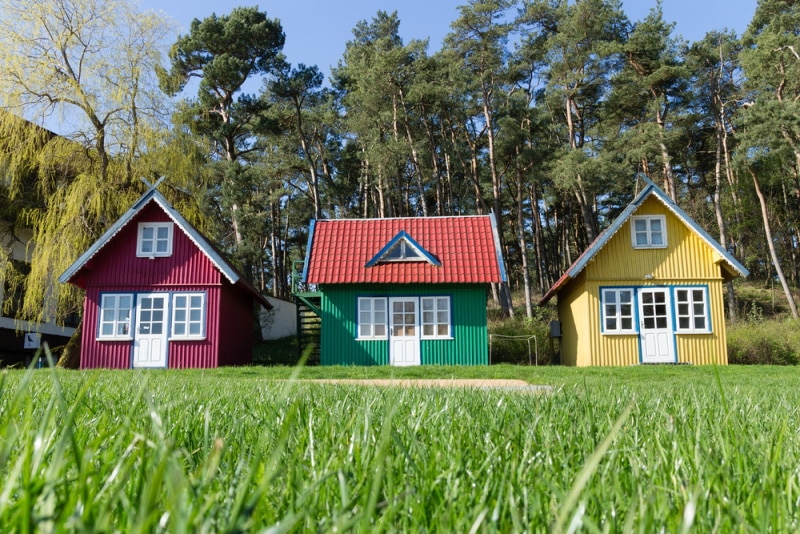
Note: This article’s statistics come from third-party sources and do not represent the opinions of this website.
With current house prices making it very difficult for people in the UK to be able to afford a new home, many are looking for alternatives. This has led to approximately 15,000 people living in houseboats and rental numbers hitting new highs. One trend that has gained a lot of interest is the concept of the tiny home: properties, typically built to fit on a standard caravan-sized trailer, and that can be moved from one location to another.
A tiny home measures less than 400 square feet, costs around £30,000 for a custom build and can save the resident as much as £1,000 a month while halving their energy consumption. Despite the benefits and a lot of passing interest, there are currently believed to be just 200 tiny homes in the country.
Below are 12 tiny home trends and statistics in the UK, including some information on the global market, and the costs and benefits of living in this type of property.
Click below to jump ahead:
The 12 Tiny Home Trends & Statistics in the UK
- There are currently around 25 million dwellings in England alone.
- The average house in the UK is 818 square feet.
- The average house price in the UK is £296,000.
- The tiny home market is expected to be worth over $4 billion, globally, by 2027.
- There are currently only 200 tiny homes in the UK.
- 15,000 people live on houseboats in the UK.
- A tiny house is considered to be anything less than 400 square feet.
- Tiny house kits are available for as little as £6,500.
- It costs between £30,000 and £55,000 for a bespoke, custom-built tiny house.
- Tiny homes do not usually require planning permission.
- Tiny homeowners use 45% less energy.
- Tiny homes save an average of £780–£1,057 per month.
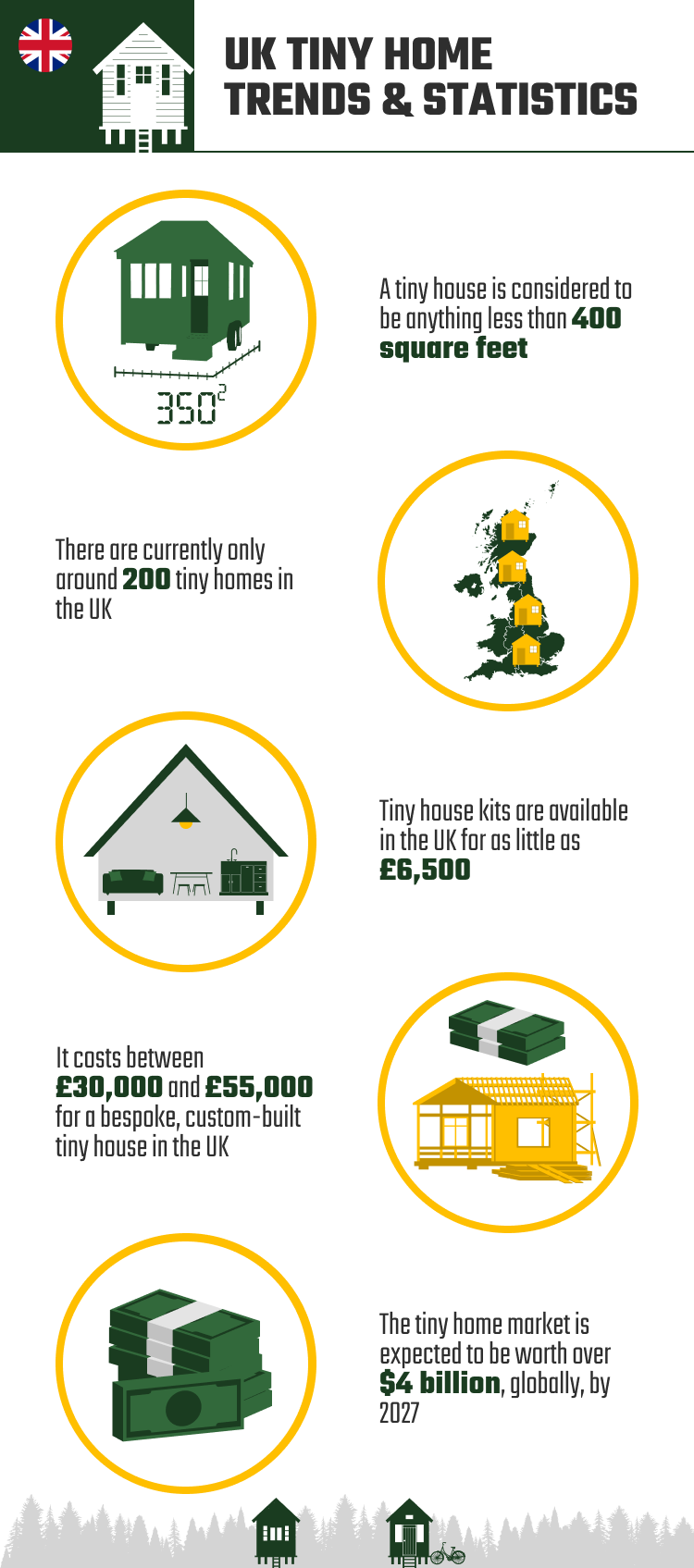
Background Data
1. There are Currently Around 25 Million Dwellings in England Alone.
(Statista)
In England, there are approximately 25 million dwellings, which include flats and houses of all sizes. The government recently set a target of building 300,000 new homes a year, but, as a result of Covid and shortfalls in the building industry, this target has not yet been hit. The number of properties has risen from 21.2 million in 2001, which means that there has been an increase of just over 3.5 million in 20 years. That’s an extra 175,000 dwellings, per annum, in England.
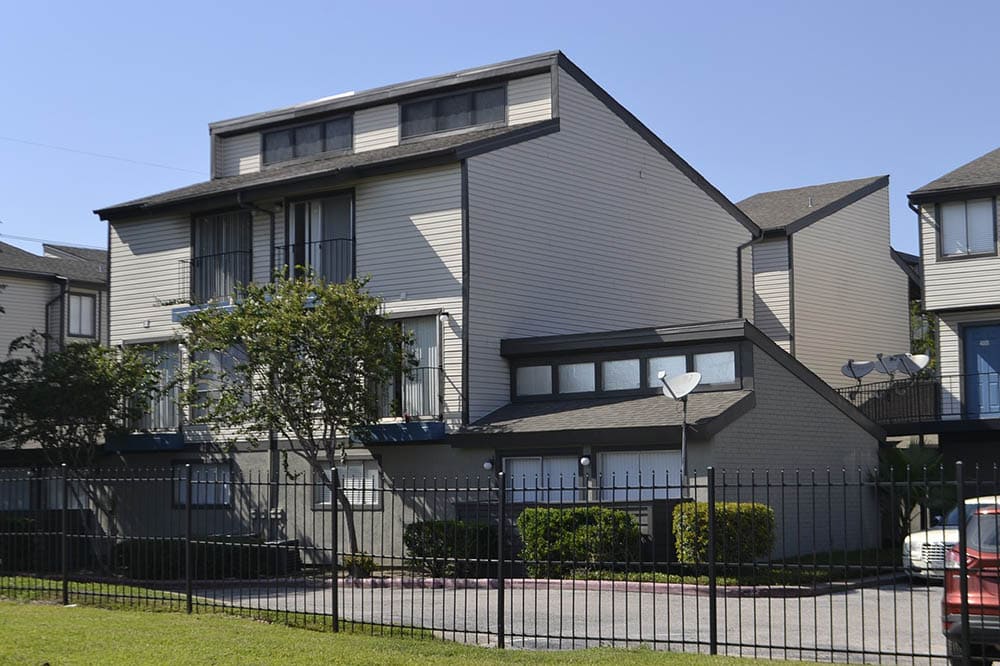
2. The Average House in the UK is 818 Square Feet.
(Shrink That Footprint)
The UK actually has small homes compared to those of other countries. The average house size in the UK is 818 square feet which is larger than in Hong Kong, with an average of 484 square feet, and in Russia and China with 614 and 646 square feet respectively. However, it is less space than France with 1,206 square feet and the U.S. with 2,164 square feet. The average size of a house in Australia is 2,303 square feet.
3. The Average House Price in the UK is £296,000.
(ONS)
Despite the houses offering relatively little space, the UK’s average house price has risen to £296,000 which is roughly similar to the average price of a U.S. home. House prices are highest in England (£316,000) compared to Wales (£220,000), Scotland (£195,000), and Northern Ireland (£169,000). The average house price has risen by £36,000 since the same time last year, which represents a 13.6% increase in prices.

The Tiny Home Market
4. The Tiny Home Market is Expected to Be Worth Over $4 Billion, Globally, by 2027.
(Technavio)
Although there is a lot of interest in the concept of tiny homes in the UK, it has not yet really taken off. Certainly not to the extent it has in some other countries. The global tiny home industry is currently worth around $3.9 billion and is expected to grow just under 5% in the next 5 years and achieve a total global value of $4.2 billion. The most growth is expected to be seen in North America, which will account for 57% of that increase, according to analysts.
5. There are Currently Only 200 Tiny Homes in the UK.
(Grand Designs Magazine)
The concept is gaining traction globally. The highest-profile proponent of tiny homes is tech mogul and occasional world’s richest man, Elon Musk, who sold several of his large homes and moved into a 375-square-foot prefabricated tiny home in Texas. Despite the interest, however, it is estimated that there are currently only 200 tiny homes in the UK, although this number is expected to increase somewhat.
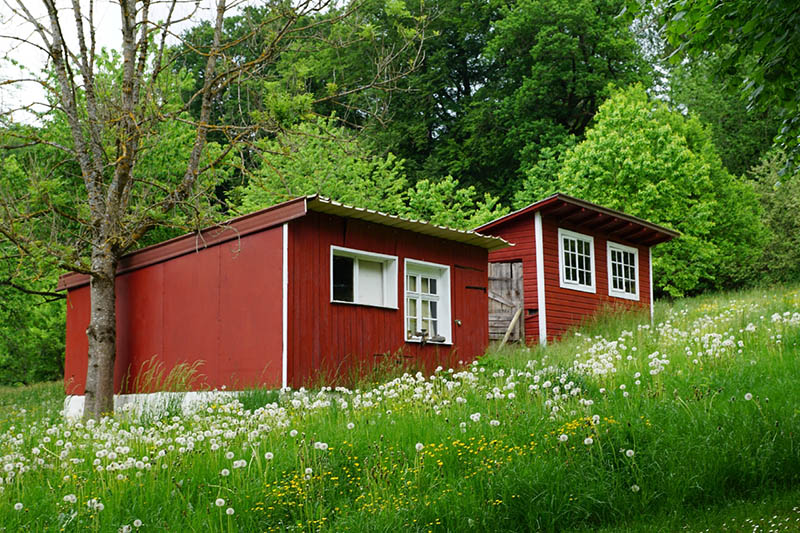
6. 15,000 People Live on Houseboats in the UK.
(Grand Designs Magazine)
Houseboats are not considered tiny homes, even though they can fall into the size requirements of the category. Houseboats typically only have one floor, but they offer many of the same benefits as tiny homes. Solar and other renewable energy sources can be used, which reduces fossil fuel consumption and minimize the owner’s carbon footprint. And, moving the boat from location to location can help avoid the mooring costs that are usually charged if the boat remains in the same place for 14 days.
Cost and Benefits
7. A Tiny House is Considered to be Anything Less Than 400 Square Feet.
(Prospect Magazine)
The most obvious feature of a tiny home is its size. To be considered a tiny house, a dwelling must measure less than 400 square feet in size. This is actually not much smaller than the 800 square feet of the average dwelling, but at that size, it is possible to have the house on wheels so that it can be moved and potentially avoid the need for planning permission.
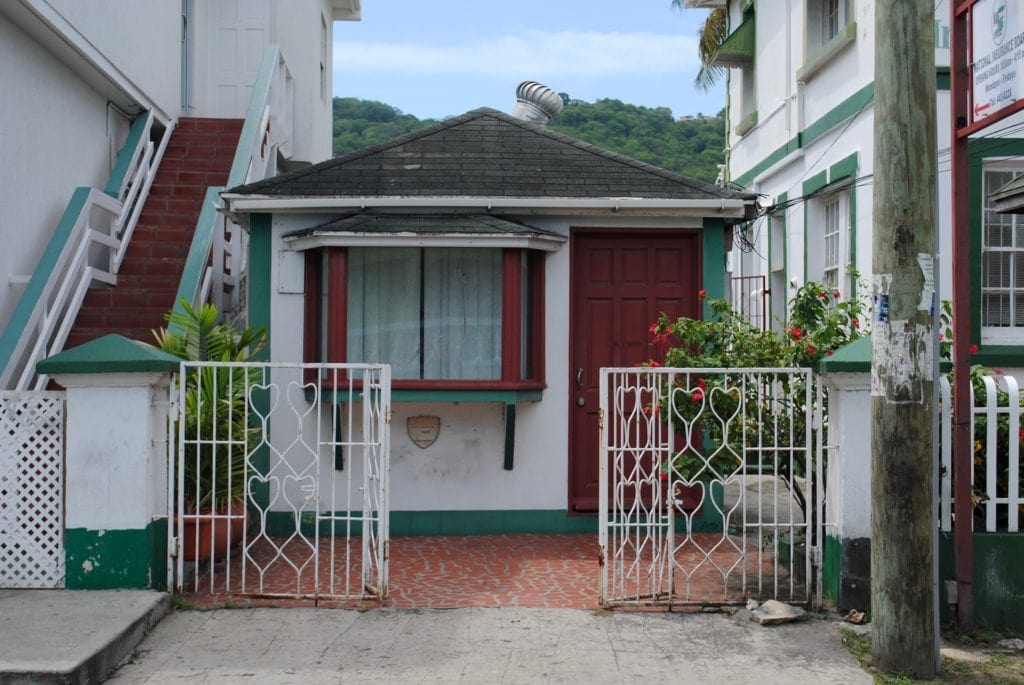
8. Tiny House Kits are Available for as Little as £6,500.
(The Switch)
A tiny house kit comes with everything required to erect or build the house yourself. It is the cheapest way to acquire one, but it does mean that the owner takes on much of the responsibility of building it themselves. Tiny house kits can be bought for as little as £6,500 although more expensive options are available.
9. It Costs Between £30,000 and £55,000 for a Bespoke, Custom-Built Tiny House
(The Switch)
Alternatively, some designers and companies offer pre-built tiny homes. In some cases, these are already designed by the company, but it is also possible for the prospective owner to work with the designer and create a bespoke home solution which the manufacturer then builds for the owner. These cost anywhere from £30,000 to nearly double that price, but even at £55,000, the cost is a lot less than buying a home.

10. Tiny Homes Do Not Usually Require Planning Permission.
(The Switch)
There are several benefits to living in a tiny home, but there are also numerous obstacles that need to be overcome. One such obstacle is where to locate the house. Most are houses on wheels, which means that they can be moved, but if the owner doesn’t already have land, it can cost several hundred pounds a month to rent land. If the owner does have land and the property is a house on wheels, it is not usually necessary to get planning permission. Buyers are advised to check with local councils to determine whether planning permission is required, especially if the tiny home will be in the same spot for longer than 28 days.
11. Tiny Homeowners Use 45% Less Energy.
(Show House)
Tiny homes have tiny energy consumption needs. They can be equipped with solar, wind, and other forms of renewable energy production, too. In any case, tiny homes use around 45% less energy than their standard home counterparts, which not only means sizeable financial savings each month but also reduces the impact on the environment.

12. Tiny Homes Save an Average Of £780–£1,057 Per Month.
(Grand Designs Magazine)
Taking into account everything from the cost of the property to the cost of heating, and other financial requirements, tiny homes can save the homeowner up to £1,057 per month. Many potential owners say that one of the main reasons they would consider moving to a tiny home is that by saving money, they won’t have to work as much and will be able to spend more time in the home that they pay less for.
Frequently Asked Questions About Tiny Homes
What is the largest size a tiny house can be?
The largest size a tiny home can be, to still be considered a tiny home, is 400 square feet. This means that the house can be built on a trailer, which means that it essentially qualifies as a caravan, rather than a house. A typical tiny house measures 8 feet wide, so the total space is ultimately determined by how long the dwelling is.
How long do tiny houses last?
It does depend on the style and quality of the tiny house as to how long it will last, but you can expect this type of construction to last up to around 30 years at least. With good care and regular maintenance, there is no reason that such a property won’t last a lifetime. (Spindrift Homes)
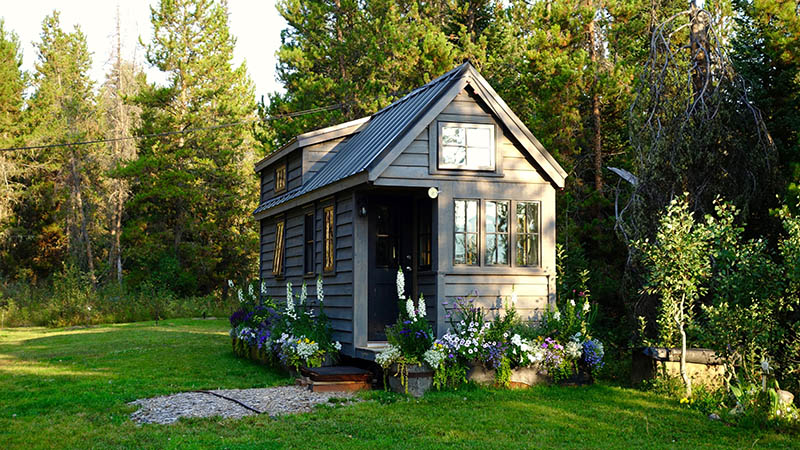
Can you get a mortgage on a tiny house?
Many banks and lenders will offer a personal loan for the purchase of a tiny house, and financing options might be available from the vendors themselves. However, prospective buyers will not be able to get a mortgage on this type of property. (The Tiny Housing Co)
Where do tiny houses get water?
There are various ways that a tiny house can get water. It is possible to have a fillable water tank, but this does take up space and can be cumbersome. Alternatively, it is possible to collect and filter rainwater for consumption and use in bathing and cleaning. It is also possible to connect the drainage to the main drains of a house or other property, with permission. (Tiny House UK)
Where does the sewage go in a tiny house?
Septic tanks are one option for the disposal of wastewater, but these take up room. A composting toilet is another option. Greywater, which is wastewater that has not come into contact with feces, can be recycled via a greywater recycling system, too.
Conclusion
There is a housing shortage in the UK that, as yet, has not been resolved by the government’s target of building 300,000 new homes a year. What’s more, house prices have risen to the extent that many people cannot afford to buy a house, let alone heat it with electricity and gas that are at their highest prices ever. One possible solution to this problem, for some people at least, is a tiny home.
These measure up to 400 square feet in size and come at a fraction of the cost. Despite a lot of passing interest in the phenomenon, however, it is believed that there are only around 200 such homes in the UK at the current time.
- See Also: Home Staging Statistics in the UK
Featured Image Credit: Segen, Shutterstock
Contents



